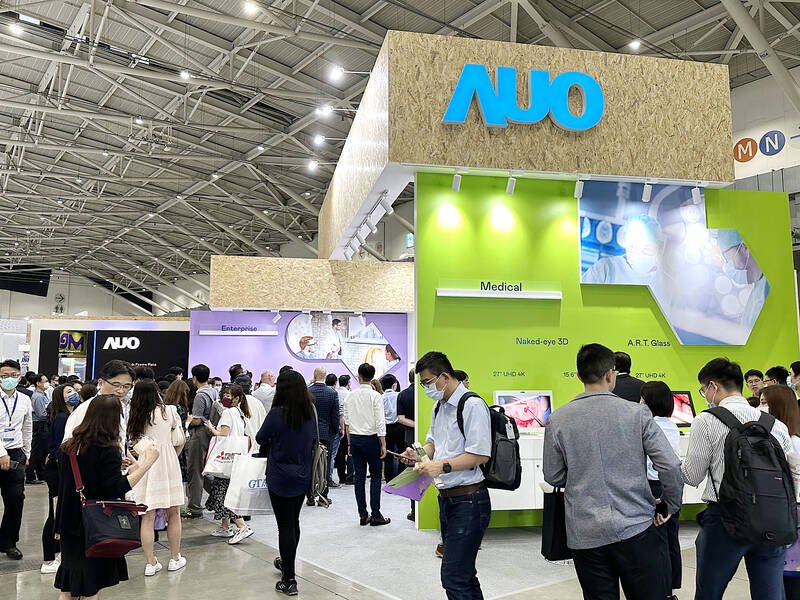Flat-panel maker AUO Corp (友達) yesterday said its losses in the first quarter of this year widened to NT$10.91 billion (US$355.3 million) due to sluggish demand for notebook computers from enterprise customers and unfavorable foreign exchange rates.
However, the company retained its growth outlook for the remainder of this year.
It was the fourth straight unprofitable quarter for the Hsinchu-based company, after registering a quarterly loss of NT$10.21 billion in the fourth quarter of last year.

Photo: Chen Mei-ying, Taipei Times
AUO blamed a foreign exchange loss of NT$1.1 billion and fewer solar module shipments for the worse-than-expected performance.
Losses in its display business improved NT$2.4 billion from the previous quarter, thanks to a pickup in panel demand for TVs, consumer PCs and consumer electronics, as panels approach supply-demand parity in the second quarter, AUO said.
Gross margin worsened to minus-9.5 percent, compared with minus-8.7 percent in the previous quarter, the company said.
“With panel supply-demand dynamics returning to a balance, prices of most panel products will stop stabilizing and even start to rebound. Therefore, we believe [revenue] will increase each quarter in the remainder of this year,” AUO chairman Paul Peng (彭浪) told an online investors’ conference.
“The second quarter will be better than the first quarter,” Peng said. “The second half will be better than the first half, based on the messages from our customers.”
The company expects a seasonal uptick in the second half, Peng said.
AUO said it has begun seeing inventory buildup demand from Chinese customers ahead of the nation’s 618 shopping festival in June, and expects the year-end holiday season in the US and Europe to further fuel panel demand in the second half.
As Chinese consumers remain conservative about spending after the COVID-19 restrictions were lifted at the beginning of this year, AUO said it is closely monitoring their spending behavior.
This quarter, shipments of TV and PC panels are expected to rise about 20 percent quarter-on-quarter, AUO said.
Average selling prices are expected to remain flat or increase mildly from US$322 per square meter during the first quarter, it said.
The company said flat panels used in vehicles would be the bright spot this quarter, with revenue from that segment expected to top NT$10 billion.
Factory utilization would increase significantly from 66 percent last quarter, AUO said.
Although most panel makers are raising equipment usage to cope with increasing demand, AUO said it does not expect oversupply risks, given most production expansion was undertaken in a disciplined manner.
To avoid boom-and-bust cycles, AUO said it is accelerating its diversification efforts and aims to boost non-panel revenue contribution to more than 20 percent in the next two to three years, from 14 percent last year.
AUO said capital spending for this year would be NT$35 billion.

Three experts in the high technology industry have said that US President Donald Trump’s pledge to impose higher tariffs on Taiwanese semiconductors is part of an effort to force Taiwan Semiconductor Manufacturing Co (TSMC, 台積電) to the negotiating table. In a speech to Republicans on Jan. 27, Trump said he intends to impose tariffs on Taiwan to bring chip production to the US. “The incentive is going to be they’re not going to want to pay a 25, 50 or even a 100 percent tax,” he said. Darson Chiu (邱達生), an economics professor at Taichung-based Tunghai University and director-general of

Hon Hai Precision Industry Co (鴻海精密) is reportedly making another pass at Nissan Motor Co, as the Japanese automaker's tie-up with Honda Motor Co falls apart. Nissan shares rose as much as 6 percent after Taiwan’s Central News Agency reported that Hon Hai chairman Young Liu (劉揚偉) instructed former Nissan executive Jun Seki to connect with French carmaker Renault SA, which holds about 36 percent of Nissan’s stock. Hon Hai, the Taiwanese iPhone-maker also known as Foxconn Technology Group (富士康科技集團), was exploring an investment or buyout of Nissan last year, but backed off in December after the Japanese carmaker penned a deal

WASHINGTON POLICY: Tariffs of 10 percent or more and other new costs are tipped to hit shipments of small parcels, cutting export growth by 1.3 percentage points The decision by US President Donald Trump to ban Chinese companies from using a US tariff loophole would hit tens of billions of dollars of trade and reduce China’s economic growth this year, according to new estimates by economists at Nomura Holdings Inc. According to Nomura’s estimates, last year companies such as Shein (希音) and PDD Holdings Inc’s (拼多多控股) Temu shipped US$46 billion of small parcels to the US to take advantage of the rule that allows items with a declared value under US$800 to enter the US tariff-free. Tariffs of 10 percent or more and other new costs would slash such

‘LEGACY CHIPS’: Chinese companies have dramatically increased mature chip production capacity, but the West’s drive for secure supply chains offers a lifeline for Taiwan When Powerchip Technology Corp (力晶科技) entered a deal with the eastern Chinese city of Hefei in 2015 to set up a new chip foundry, it hoped the move would help provide better access to the promising Chinese market. However, nine years later, that Chinese foundry, Nexchip Semiconductor Corp (合晶集成), has become one of its biggest rivals in the legacy chip space, leveraging steep discounts after Beijing’s localization call forced Powerchip to give up the once-lucrative business making integrated circuits for Chinese flat panels. Nexchip is among Chinese foundries quickly winning market share in the crucial US$56.3 billion industry of so-called legacy